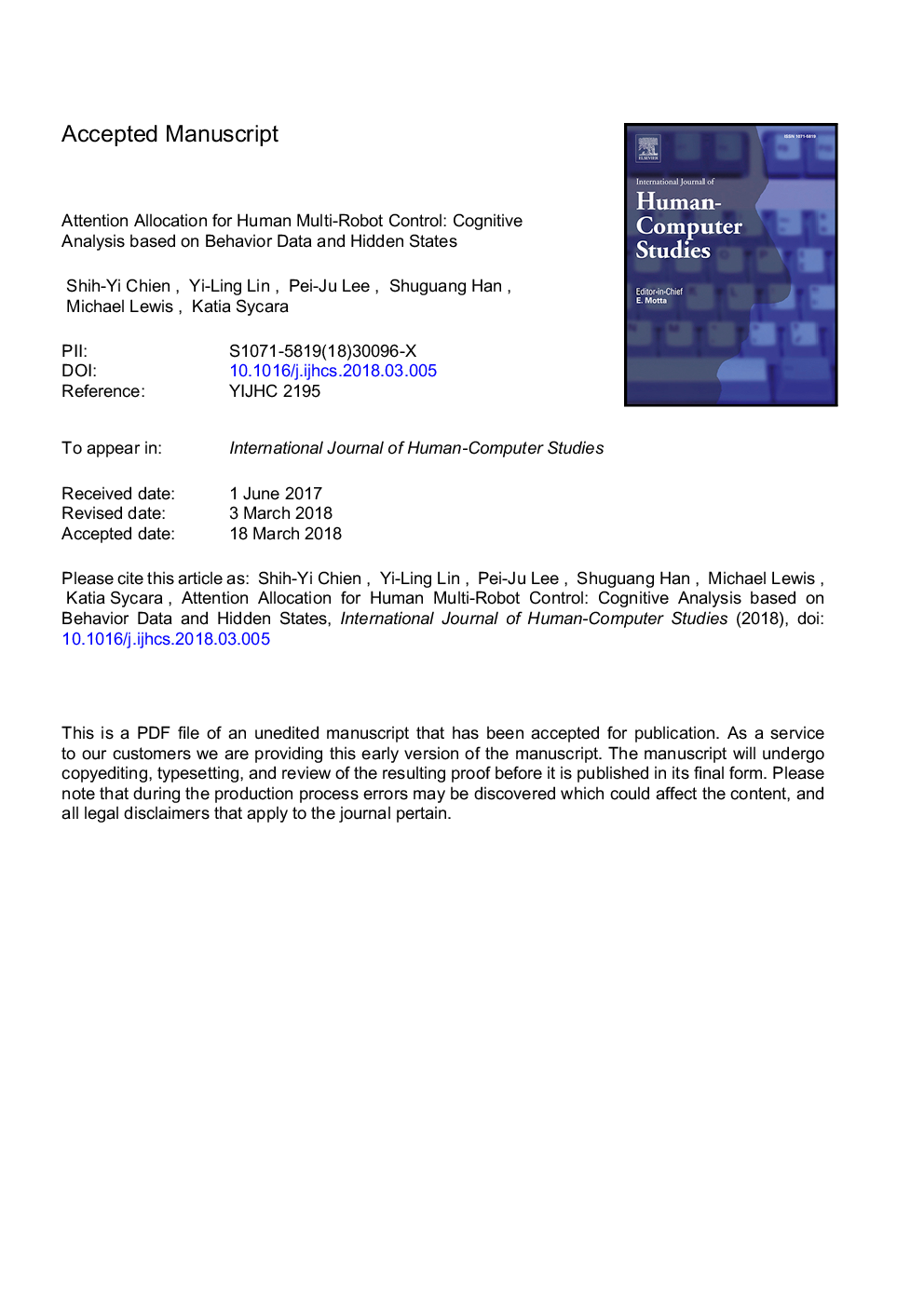| کد مقاله | کد نشریه | سال انتشار | مقاله انگلیسی | نسخه تمام متن |
|---|---|---|---|---|
| 6860947 | 1438937 | 2018 | 20 صفحه PDF | دانلود رایگان |
عنوان انگلیسی مقاله ISI
Attention allocation for human multi-robot control: Cognitive analysis based on behavior data and hidden states
ترجمه فارسی عنوان
تخصیص توجه برای کنترل چند ربات انسان: تجزیه و تحلیل شناختی بر اساس داده های رفتار و حالت های پنهان
دانلود مقاله + سفارش ترجمه
دانلود مقاله ISI انگلیسی
رایگان برای ایرانیان
کلمات کلیدی
تعامل انسان و روبات، دستیار شناختی، تعویض وظیفه، مدل مخفی مارکف، قابلیت اطمینان سیستم، برنامه ریزی،
موضوعات مرتبط
مهندسی و علوم پایه
مهندسی کامپیوتر
هوش مصنوعی
چکیده انگلیسی
Human multi-robot interaction exploits both the human operator's high-level decision-making skills and the robotic agents' vigorous computing and motion abilities. While controlling multi-robot teams, an operator's attention must constantly shift between individual robots to maintain sufficient situation awareness. To conserve an operator's attentional resources, a robot with self-reflect capability on its abnormal status can help an operator focus her attention on emergent tasks rather than unneeded routine checks. With the proposing self-reflect aids, the human-robot interaction becomes a queuing framework, where the robots act as the clients to request for interaction and an operator acts as the server to respond these job requests. This paper examined two types of queuing schemes, the self-paced Open-queue identifying all robots' normal/abnormal conditions, whereas the forced-paced shortest-job-first (SJF) queue showing a single robot's request at one time by following the SJF approach. As a robot may miscarry its experienced failures in various situations, the effects of imperfect automation were also investigated in this paper. The results suggest that the SJF attentional scheduling approach can provide stable performance in both primary (locate potential targets) and secondary (resolve robots' failures) tasks, regardless of the system's reliability levels. However, the conventional results (e.g., number of targets marked) only present little information about users' underlying cognitive strategies and may fail to reflect the user's true intent. As understanding users' intentions is critical to providing appropriate cognitive aids to enhance task performance, a Hidden Markov Model (HMM) is used to examine operators' underlying cognitive intent and identify the unobservable cognitive states. The HMM results demonstrate fundamental differences among the queuing mechanisms and reliability conditions. The findings suggest that HMM can be helpful in investigating the use of human cognitive resources under multitasking environments.
ناشر
Database: Elsevier - ScienceDirect (ساینس دایرکت)
Journal: International Journal of Human-Computer Studies - Volume 117, September 2018, Pages 30-44
Journal: International Journal of Human-Computer Studies - Volume 117, September 2018, Pages 30-44
نویسندگان
Shih-Yi Chien, Yi-Ling Lin, Pei-Ju Lee, Shuguang Han, Michael Lewis, Katia Sycara,
